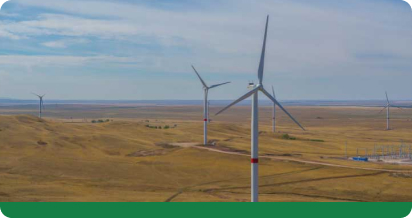One of the key directions in achieving our goals in the field of low-carbon development is the most rational use of fuel and energy resources. In this regard, we pay great attention to improving energy efficiency and energy and resource conservation in all Portfolio Companies. The Fund has adopted an Energy and Resource Conservation Program until 2027, which defines the goals and objectives of the Fund group in the field of energy and resource conservation and energy efficiency improvement, as well as sets priorities and principles for the implementation of energy conservation and energy efficiency measures.
The total energy consumption within the Fund in the reporting year amounted to 594.19 million GJ, as compared with 2021 there is a slight increase of 0.08 %. Over the period 2018–2022, there was increase in the level of consumption of energy resources by 6.9 %, due to growth of electricity production at coal-fired power plants of Samruk-Energy JSC, the launch of the Karabatan gas turbine power plant of Karabatan Utility Solutions LLP, increased consumption of gas for own needs and process losses, resulting in increased consumption of coal and natural gas.
In the structure of energy consumption from non–renewable sources according to the Fund in 2022, coal occupies about 55 %, gas – 18 % (including natural gas – 15 %, other types – 3 %), liquid fuel – 8 % (including diesel fuel – 5 %, other types – 3 %), refinery gas and electricity from external sources – 7 % each. GRI 302-1
The largest consumption of energy resources falls on the electricity and heat production sector – 57 % (340.2 million GJ in 2022), due to the specifics of the company activities. The basis of consumption is coal from the Bogatyr mine, the consumption of which for the production of electric and thermal energy at the Fund coal-fired power plants exceeds 18 million tons of coal per year. The energy intensity of the electricity and heat production sector in the reporting year was 9.5 GJ/thousand kWh. GRI 302-3
The oil and gas refining sector accounts for 12 % (68.6 million GJ in 2022) of the total consumption of the Fund energy resources. The energy intensity of the sector is 3.8 GJ/tonne of refined oil (gas). The oil and gas exploration and production sector consumes about 10 % (58.2 million GJ in 2022), the oil and gas transportation sector consume 8 % (49.5 million GJ in 2022) of the total consumption of the Fund energy resources. In the oil and gas exploration and production sector, the energy intensity was 2.8 GJ/tonne of produced СРС, in the oil and gas transportation sector – 0.7 GJ/tonne of transported oil (gas). GRI 302-3
The share of the railway transportation sector is 7 % (40.9 million GJ in 2022) of the total consumption of the Fund energy resources. On the balance sheet of JSC NC Kazakhstan Temir Zholy there are more than 16 thousand km of railway tracks and about 1.7 thousand locomotives. Electric power from external sources (29 % – 11.8 million GJ in 2022) and diesel fuel (64 % – 26.4 million GJ in 2022) are consumed for train traction, which in total is about 93 % of the total consumption of the sector. The rest of the sectors account for 7 % of total energy consumption.
Energy consumption from renewable sources in 2022 amounted to 96 thousand GJ, of which 43 thousand GJ is purchased one, 53 thousand GJ is own production. GRI 302-1
As part of the ongoing work on energy and resource conservation and energy efficiency improvement in 2022, the total amount of energy saving amounted to 16.5 million GJ. The sector of electricity and heat production has carried out 58 measures aimed at reducing the consumption of fuel and energy resources, which has saved more than 14.2 million GJ of fuel. By the end of 2022, the consumption of electric energy by the sector decreased by 2 % as compared to last year, and the consumption of thermal energy also significantly decreased as compared to last year (by 7 %). GRI 302-4
In sectors of refining, exploration and production and transportation of oil and gas, more than 49 measures have been carried out this year under the Low-carbon Development Plan, the estimated annual savings of fuel and energy resources amounted to 2.1 million GJ.
Further growth areas
Our main objectives in the field of energy conservation until 2027 are:
- reducing the energy intensity of the products of five large companies of the Fund by 10 % by 2027 (from the base year 2021), which will ensure the solution of the problem of reducing the energy intensity of the gross domestic product of the Republic of Kazakhstan;
- continuous improvement of the energy efficiency of production processes based on effective process management and the use of innovative technologies and equipment;
- creation of optimal organizational and economic conditions for achieving the Program targets;
- efficient use and reduction of consumption of fuel, energy and water resources;
- implementation of the system of energy efficiency indicators of the energy management system.
In the electricity and heat generation sector, the construction of new coal-fired generation facilities and the modernization of existing stations assumes that the main and auxiliary equipment of the new stations will be installed given the use of the latest energy-efficient technologies in order to reduce the specific costs of conventional fuel, which will subsequently affect the reduction of greenhouse gas emissions.
As part of the implementation of the Energy Transition Program of Samruk-Energy JSC for 2022–2060, the sector is working to increase the share of renewable energy sources in the generation structure. The goal of the Program is to reduce net carbon footprint of Samruk-Energy JSC by 2060.
In order to achieve the target indicator on reducing the carbon footprint and meeting the growing demand for electricity, it will be necessary to implement a number of new wind and hydroelectric power plants with a total capacity of about 6,000 MW. By 2060, Samruk-Energy JSC plans to build about 200 MW of solar generation, as well as the construction of a pilot project of a geothermal power plant with a capacity of 20 MW. Samruk-Energy JSC also plans to study the prospects for the development of hydrogen energy to reduce the carbon footprint as a universal secondary energy carrier.
In sectors of refining, exploration and production and transportation of oil and gas, a Low-carbon Development Program was developed for the period 2022–2031, within the framework of which the following energy saving goals were set, in particular:
- harmonization of the automated energy management system with the production process;
- implementation of an energy efficiency improvement policy with motivation tools for employees of JSC NC KazMunayGas to make rationalization proposals;
- optimization of the regulatory and technical base in the field of energy consumption and resource conservation.
As part of the Low-Carbon Development Program for the period 2022–2031, JSC NC KazMunayGas also plans to develop the use of renewable energy sources.



